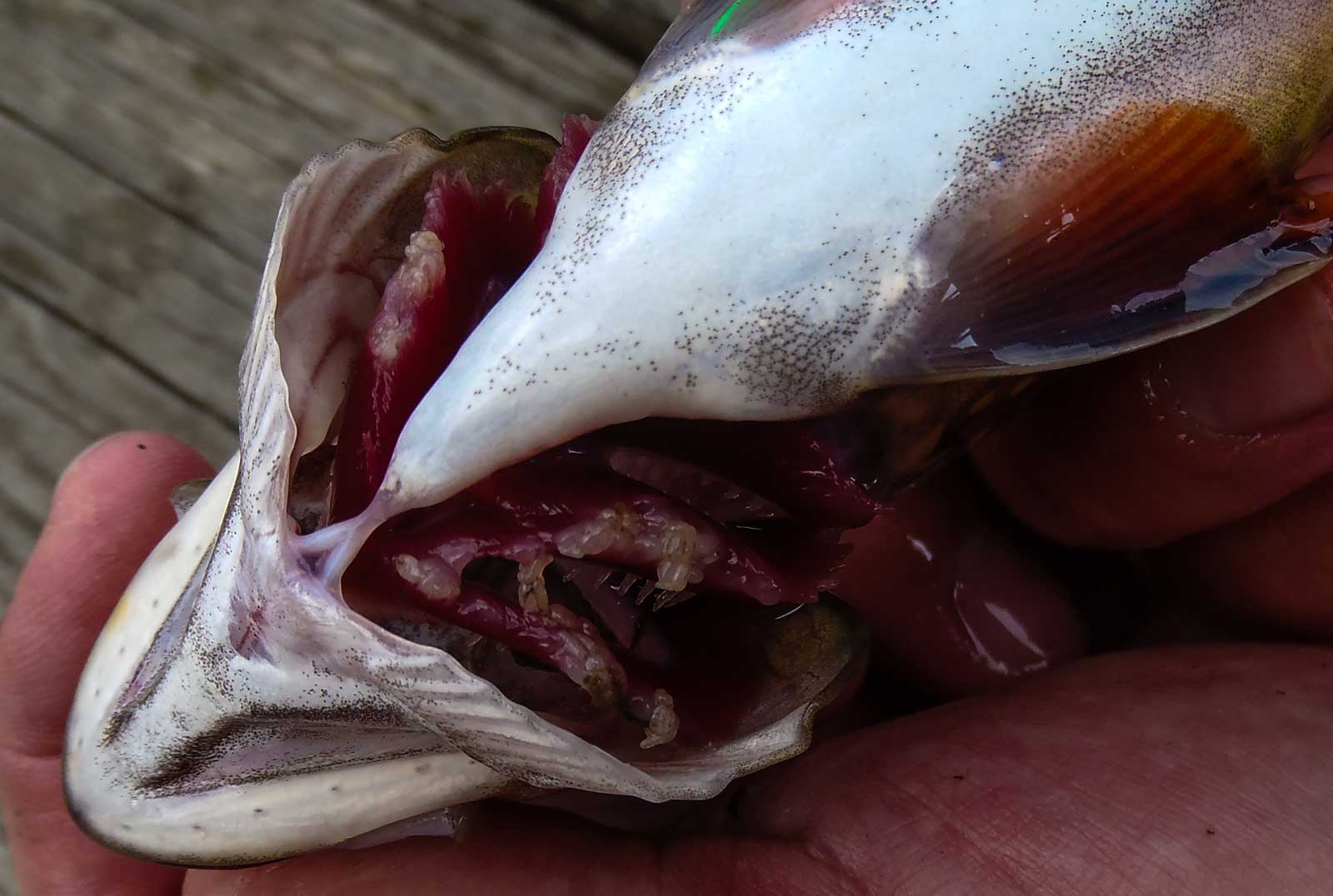Gill lice in a Wisconsin brook trout. Photo courtesy of Wisconsin Trout Unlimited.
By Jack Williams
In Wisconsin, Department of Natural Resources staff are finding increasing rates of gill lice parasitism in brook trout as waters warm. In North Carolina, the same gill lice have been found for the first time on brook trout from the Cullasaja River drainage. In both cases, state biologists are asking anglers for help in tracking this parasite.
Gill lice are a type of copepod parasite that attach to the gills and opercula of brook trout. The parasite, Salmincola edwardsii, only infects fish of the genus Salvelinussuch as brook trout, and not rainbow or brown trout. The parasite naturally occurs in northern states like Wisconsin but until recently, has not been recorded from southern states.
In Wisconsin brook trout, parasite infestations follow warm winters
Matt Mitro of Wisconsin DNR reported at the recent Wild Trout Symposium that the incidents of gill lice in some brook trout populations has risen to a 95 percent infection rate. Heavily infested brook trout may not be able obtain sufficient oxygen and often are in poorer condition going into winter. Warmer stream temperatures are implicated in recent brook trout declines in Wisconsin and increases in gill lice parasitism.
As waters warm, non-native brown trout also move in, so it’s hard to tell what is stressing the brook trout more: warmer water, invasive brown trout or the gill lice. It’s likely all three – an unfortunate triple whammy. Regardless of the cause, the result is the same: fewer brook trout.
Wisconsin Trout Unlimited is asking anglers to check for the presence of gill lice in brook trout. Check their website for tips on identifying the white parasites on the red gills of brook trout. Remember not to touch the gills of any trout you plan to release.
In North Carolina, a disturbing discovery
Jacob Rash of North Carolina Wildlife Resources Commission recently reported on what may be the first observation of gill lice on brook trout in the South. Gill lice were found on brook trout from several headwater streams of the Cullasaja River system in Macon County.
How did the gill lice get there? Hard to tell, perhaps from some ill-conceived introduction. What are the implications of the introduction? Also hard to tell, but as gill lice stress native brook trout, the native trout become more and more susceptible to other problems, such as warming waters and invasions of non-native fishes, like brown trout and rainbow trout.
If you see any gill lice in brook trout caught from North Carolina waters, Jacob Rash would like to hear about it by email at Jacob.rash@ncwildlife.org.
Invasive species and climate change
Warmer water spells trouble for native trout. Parasites and diseases can proliferate in warmer conditions. For example, as brook trout become stressed and their ability to compete successfully with browns, rainbows or warm-water fishes is diminished.
For a native trout already suffering from warming stream temperatures, with predicted further losses of habitat in the future, gill lice may pose one more twist in climate change scenario. Wisconsin Trout Unlimited is working actively with the Wisconsin Department of Natural Resources to get a grip on the problem, helping with outreach and education as well as an intensive effort to encourage anglers to report their observations of the parasite. Check out the Wisconsin TU websitefor more information.
What else can anglers do to engage on the issue of climate change? Plenty. Stream temperature can be monitored with easily installed temperature loggers. Changes in the timing of aquatic insect emergence can be tracked in response to earlier runoff and warmer conditions. See our Angler Science program at TU for descriptions. Anglers can help streams prepare for climate change by replanting riparian vegetation to cool water and halt erosion, or by inserting logs or boulders that provide cold-water refuges as higher flows impact the structures and dig out pools. The key is getting involved, whether monitoring streams, restoring habitats or improving policies.
Jack Williams is TU’s senior scientist. He works from Medford, Ore.



